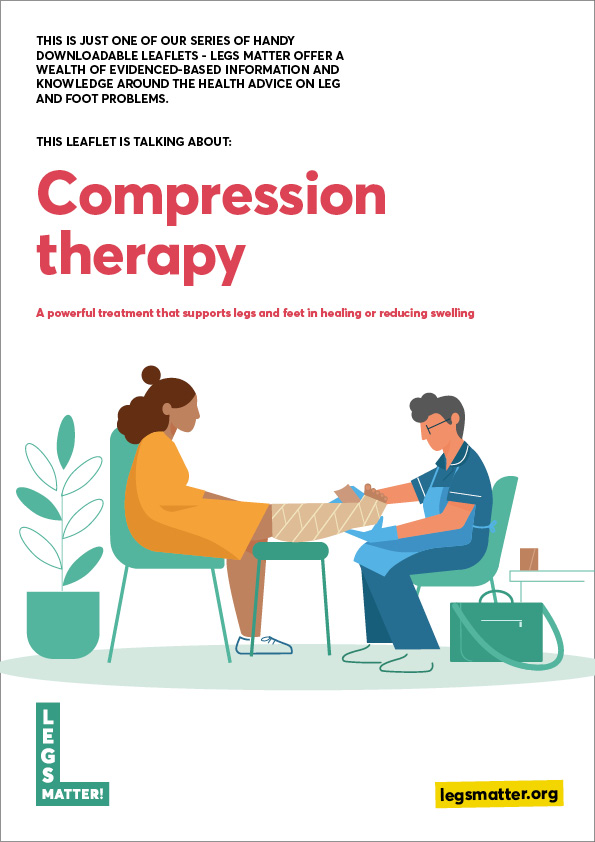Compression therapy helps increase blood circulation in the lower legs, ankles and feet. It’s an effective treatment for venous leg ulcers, lymphoedema and lower leg swelling.
It is common for people to want to avoid compression therapy because it can feel an extra burden to get on or have as a treatment. You might have already had a bad experience that has knocked your confidence in compression therapy as a suitable treatment.
The problem is that it works! And to date there is no medication or treatment that is as effective as a compression garment or bandage on the leg!
What is compression therapy?
Compression therapy is a powerful treatment regime that supports legs in their healing or reduction in swelling. It can seem old fashioned or difficult to use but it is incredibly effective and has a great deal of research to underpin its use and tell us how important it is as a treatment.
Legs create problems for wounds because of gravity – what a wound on the arm or abdomen needs to heal is very different for a leg. Legs need support to heal and even more so if there is underlying venous disease, leg swelling or excess weight or immobility.
If your wound isn’t healing because of venous hypertension and there are no problems with the blood supply to your legs, then you must be offered compression therapy to aid wound healing.
What is compression therapy good for?
Compression therapy improves the return of your venous blood supply by applying supporting pressure to the leg and foot. This can be done by bandaging the lower leg or by wearing medical support socks, stockings or tights. Compression therapy is very effective at reducing swelling, improving blood flow in the veins and healing or preventing sores or ulcers.
Research is increasingly pointing to the role of compression therapy in reducing inflammation around the wound or swelling; compression will have a direct impact on reducing pain, reducing swelling, reducing skin colour changes and supporting the calf and foot muscles to work more effectively. Using compression with ankle and calf exercises is important and will make the compression therapy more effective.
What are the different types of compression therapy?
There are lots of different types of compression therapy so ask your nurse to find something that is right for you.
Compression therapy can be provided by
- Various bandage regimes
- Hosiery or garments
- Wraps
Compression comes in different strengths or classes and is measured in mmHg. Similarly to medication, the dosage of compression you need is to do with what works for you (your height or weight) or how bad your problem is; if you have had deep venous thrombosis you may need stronger compression than someone who has some superficial varicose veins. Compression bandage therapy also reduces its compression dosage or strength on larger legs.
Asking for the correct dosage of compression therapy
Scientific evidence tells us that strong compression therapy is needed to heal venous leg ulcers. Unfortunately, across the UK many patients are having a reduced dosage of compression therapy and are not healing.
Top tip: ask your healthcare provider if you are having strong compression therapy. Having reduced or light levels of compression is like taking half a tablet of Paracetamol for a headache. It is unlikely to work! So the dosage of compression needs to be strong enough to work for your leg and your condition
Reduced compression dosage may be required if:
- You have mild disease or a small leg ulcer or wound. You may be offered Class 1 Compression socks
- You are in significant pain. A reduced dose of compression will help you get accustomed to the compression bandage. But if this dose does not reduce the swelling or wound exudate, then this is not creating an effective therapy and you need stronger compression.
- You have moderate or mild peripheral arterial disease plus a leg ulcer
Strong compression dosage is required for:
- All venous leg ulcers. You will be offered Class 2-3 socks or wraps, a hosiery kit or a variety of compression bandage regimes
- A variety of leg ulcers of other causes, especially if you are tall, have a lot of swelling or have large legs
Does compression therapy hurt?
Compression can be a little uncomfortable when you first start treatment but should not cause you any pain. Any discomfort should reduce as the swelling goes down. If you do experience discomfort or have difficulty with footwear talk to your nurse or doctor about it and they will advise you on ways of alleviating this. Often people are fearful of compression, fearing that it is ‘cutting off the circulation’. They may have heard that a relative had to have an amputation for a foot ulcer. Express your concerns and the healthcare practitioner will be able to reassure you that your wound, if prescribed compression will only benefit you and not create harm.
The only time when compression must not be used without specialist advice is when you have critical ischaemia or significant peripheral arterial disease.
Remember! Compression therapy is a critical part of a treatment plan which will speed up healing. It is likely that if you do not use it or find a regime or compression dosage that works, your wound and swelling will simply deteriorate. Getting the dosage right is essential and needs having a good conversation with your nurse or therapist.
Effective compression therapy
It is essential that everyone who needs it has access to this
Lack of access to this important therapy is harmful because it increases the risk of leg wounds not healing or becoming very debilitating and painful. Lack of effective treatment can lead to lives ruined. You have a right to expect evidence based care.
If you think you are not receiving effective or consistent compression therapy, talk to your nurse or therapist; make a note of what you want to talk about and even take a friend with you for support as this sort of conversation can feel tricky. Ask questions and expect answers.
Compression therapy downloadable leaflet (PDF)
We’ve created a handy downloadable leaflet of the key information on this page so you can easily print it out for personal reference or to hand to a patient or healthcare professional. Or you can also simply forward it on by email.
Other support
Some organisations you can contact for further information.
Accelerate Based in East London, Accelerate can accept national referrals from your GP / specialist to our world-class centre where we pioneer and trial experimental new treatments for chronic leg ulcers / wounds, lymphoedema and mobility challenges.
Contact details
020 3819 6022
hello@acceleratecic.com
Find out more on the Accelerate website
The Lindsay Leg Club Foundation Promoting and supporting community based treatment, health promotion, education and ongoing care for people who are experiencing leg-related problems - including leg ulcers and other wound care issues.
Contact details
01473 749565
lynn.bullock@legclubfoundation.com
Find out more on the Lindsay Leg Club Foundation website
NHS Choices the official NHS website, which provides vital information and support about leg and foot signs and other symptoms.
Contact details
Call 111 - for non-emergency medical advice
Find out more on the NHS Choices website










